Wood Stove Installation Cost for Tiny Houses: A Complete Breakdown
- October 9, 2023
- 1 comment
Living in a tiny house is about more than minimalism; it’s about maximizing every square foot for both functionality and comfort. Among the challenges of tiny house living, heating is a significant one. It’s not just about choosing a heating source; it’s about finding one that fits well in a limited space and doesn’t break the bank.

My experience installing a grizzly wood stove in my tiny house, which measures 24 feet long, 8.5 feet wide, and nearly 12 feet high, highlights these challenges. I’m excited to share the insights I’ve gained, including the costs and logistics, to help you understand what installing a wood stove in a tiny home entails.
Starting Out: The Stove Purchase
Back when I made my purchase, I ordered the Grizzly wood stove from Cubic Mini Wood Stoves, a renowned Canadian brand, for $600. However, for those considering a similar purchase now, you’re in for a pleasant surprise: the stove is currently on sale for $461.00. With shipping and customs, my initial expenditure rose by another $85, bringing my total to $684.
One of the primary reasons I gravitated towards this specific stove was its robust heat output, which ranges between 8,000 BTU and 18,000 BTU. In energy terms, that translates to an impressive 2.3 to 5.2 KWh. Such heating prowess, coupled with its compact size, made it the perfect fit for my tiny home. The brass plated coil handles added an aesthetic appeal and also ensured safety during operation.
Yet, the stove is just the beginning. The installation and accessories come with their own set of costs, which are essential to factor in when planning your heating solution.
Detailed Cost Breakdown and Tips
1. Foundation and Fireproof Pad
I constructed the foundation myself, which can be a cost-saving measure if you’re handy. But for those who might not be as DIY-savvy, consider outsourcing this.
Pro Tip: Don’t skimp on the fireproof pad. I got mine from Lowe’s for $100, ensuring it was of good quality to prevent any potential fire hazards.
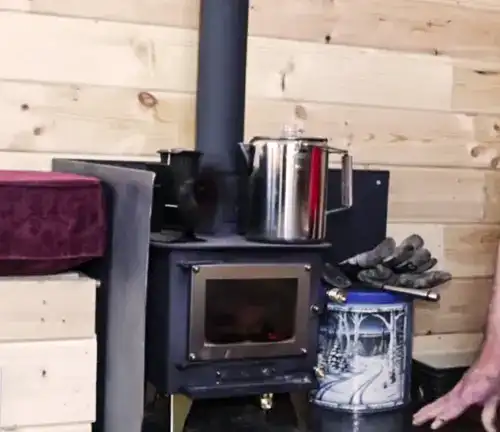
2. Surround
This isn’t just a design element but is crucial for safety. I got mine custom-made at a local welding shop for $80. It’s worth investing in a well-crafted surround; after all, it’s a barrier between the hot stove and your home’s interior.
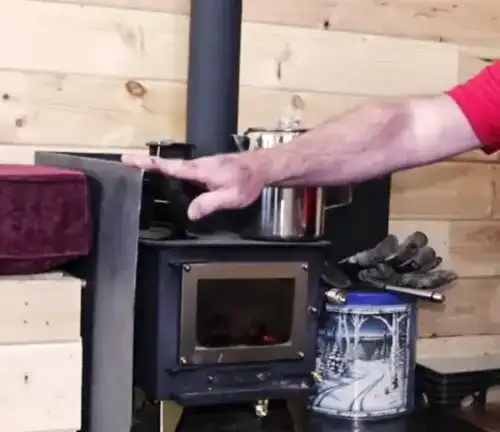
3. Flue Pipe Assembly
The flue system can be a bit intricate. Between the connector ($16), various pipe sections ($28, $23, and another $23), the elbow ($50), and the wall thimble ($41), it’s essential to ensure that all these parts fit perfectly. My total here was $181.
Pro Tip: Always double-check measurements before purchasing and ensure they’re compatible with your stove’s specifications.

4. Exterior Components
Ensuring the external components are weatherproof is vital. I spent $50 on a cleaning tee, $40 each on three 3-foot pipe sections, and $20 on a chimney cap. Remember, these components will be exposed to the elements, so go for rust-resistant and durable options.

5. Final Touches
Aesthetics matter, even for utility installations. I opted for an elegant black finish, costing me $15 in paint. Additionally, sealing gaps is essential to prevent smoke leaks, so investing in high-temperature caulk was a must, adding another $14.
Pro tip: Always apply caulk in well-ventilated areas and let it cure thoroughly before lighting the stove.
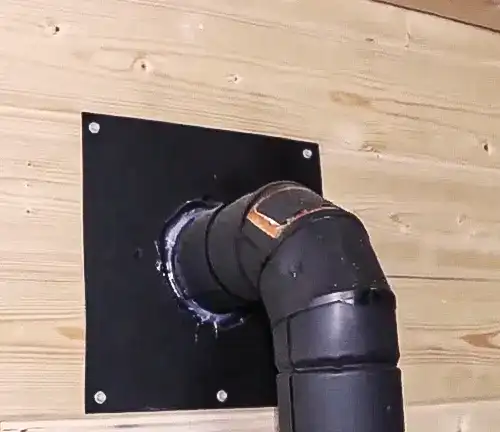
The sum of all these parts brought my total to roughly $1,400. And while the stove might appear as the main expense at first glance, the associated accessories quickly add up. So, when budgeting, always account for these ‘extras’ and remember that safety and quality should be top priorities.
Operational Overview
Although I’ve managed to source my wood for free from a local lumberyard, the stove’s efficiency is pivotal. On nights when I fill it up with ample logs and manage its burning rate, it can provide warmth for 2 to 3 hours. Accounting for the heat emanating after the fire dies, it sums up to roughly 3.5 to 4 hours of consistent warmth.
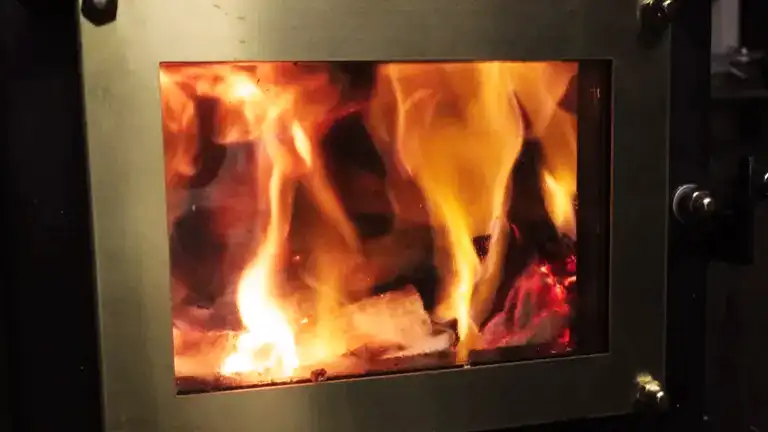
To ensure I never wake up to a frigid morning, I’ve incorporated an RV propane-vented heater. This marvel automatically kicks in when the temperature drops, maintaining a snug ambiance.
The Material Debate
The stove’s plate steel construction certainly gives it a distinct identity, especially when compared to the prevalent cast iron variants that grace many tiny homes. Cast iron’s reputation for extended heat retention is well-founded, but the blend of plate steel and the stove’s internal fire brick in my current setup hasn’t disappointed me.
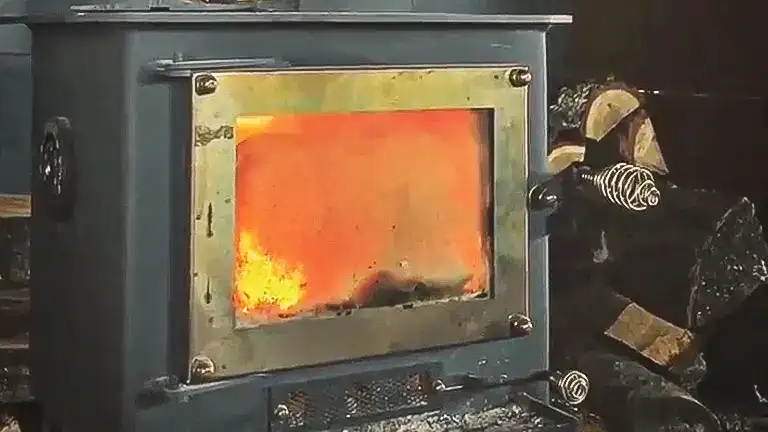
However, there’s always room for improvement. One area I’ve contemplated is the stove’s log capacity. While the current 6-inch limitation is workable, a stove that could accommodate 7 to 8-inch logs would offer several benefits:
- Longer Burn Time: Bigger logs would naturally burn longer, reducing the frequency of refueling and ensuring a consistent warmth over extended periods.
- Better Fuel Efficiency: Using larger logs could potentially mean using fewer of them over the same duration, leading to better fuel efficiency.
- Convenience: Fewer reloads translate to less manual intervention, making the heating experience smoother and more user-friendly.
As my tiny house is still a work-in-progress, any major changes or upgrades to the heating system are on pause. Once the insulation is in place, and the house is complete, I’ll be in a better position to evaluate the stove’s performance and decide on potential upgrades.
Conclusion
As we reach the end of this heating odyssey, there are a few key takeaways to keep in mind:
- Holistic View of Costs – The stove, while a crucial component, represents just a segment of the overall expenditure. When tallying up the costs of accessories, installations, and any unexpected additions, you’re looking at a comprehensive expenditure of around $1,400.
- The Importance of Material Choices – The construction of my stove, dominated by plate steel, serves its purpose, but other materials, like cast iron, might offer extended heat retention. Furthermore, the stove’s log capacity can influence its functionality. For instance, accommodating larger logs, say 7 to 8 inches, can enhance burn times and overall convenience.
- Strategic Planning is Key – The path to an efficient heating solution in a tiny home demands foresight and planning. While my ongoing house construction offered a temporary hiatus, it also afforded valuable time to reflect, research, and strategize for future heating needs.
For those on the brink of their own tiny house heating journey, a few parting tips:
- In-depth Research – Delve into the specifics of different stove materials, sizes, and features. Understand what aligns best with your needs.
- All Costs Matter – Avoid tunnel vision focused solely on the stove’s price. The peripherals, from installation to accessories, can add up and should be part of your budget considerations.
- Never Compromise on Safety – Your safety and that of your home should always be paramount. This translates to ensuring quality materials, adhering to installation guidelines, and staying committed to regular maintenance.
Embracing the tiny house lifestyle doesn’t mean skimping on comfort. With the right heating solution, you can ensure warm, cozy winters without compromising on space or aesthetics.
Seeking an article on wood stove installation? Browse our collection here!
- How to Remove Rust and Restore a Wood Stove 2023
- How to Install a Wood Stove in the Basement 2023
- How to Install a Wood Stove
- Best Cheap Wood Stoves: Buyer’s Guide
- How to Choose the Best Wood Burning Stove Insert 2023
- Best Small Wood Stoves on Amazon 2023
- Best Cheap Small Wood Stove of 2023 Under $150
FAQs
- Why is the cost of wood stove installation often higher for tiny houses compared to traditional homes?
Tiny houses often require specialized or compact designs to maximize space. Additionally, customized installations to meet the unique spatial constraints of a tiny home can raise costs. - How does the size of a tiny house influence the type and cost of the wood stove to be installed?
The smaller the house, the less heating capacity is needed, leading to a smaller stove. However, very compact stoves, designed specifically for tiny spaces, might sometimes be pricier due to their specialized design. - Are there any hidden costs associated with wood stove installation in tiny houses that owners should be aware of?
Yes, costs can arise from specialized ventilation systems, additional safety features, or modifications to fit the stove seamlessly into the tiny home’s design. - Do mobile tiny houses have different installation costs or requirements compared to stationary ones?
Mobile tiny houses might require additional stabilization and safety features for the stove, which can add to the installation costs. - How does the insulation level of a tiny house affect the choice and cost of a wood stove?
Better-insulated homes retain heat more efficiently, possibly allowing for a smaller or less expensive stove. Conversely, less insulation might necessitate a stove with higher output, potentially increasing costs. - Are there any eco-friendly wood stove options tailored for tiny houses? Do they come at a premium cost?
Yes, there are eco-friendly stoves designed to produce fewer emissions. While they might come at a slightly higher upfront cost, they can be cost-effective in the long run due to reduced wood consumption and potential tax credits. - Is it more cost-effective to DIY the installation or hire a professional for wood stoves in tiny homes?
While DIY can save on labor costs, hiring a professional ensures safety and compliance with local codes. Mistakes in DIY installations can lead to costly repairs or safety hazards. - How do local regulations and codes impact the cost and type of wood stove installations in tiny houses?
Local codes might mandate specific safety features or stove types, which can influence both the cost and the kind of stove you can install. - What are the long-term cost implications of choosing a higher-end wood stove model for a tiny house?
While the initial cost is higher, premium models might offer better efficiency, longevity, and reduced maintenance costs, making them more cost-effective in the long run. - Can multi-functional wood stoves (like those with ovens) be effectively installed in tiny homes, and how do they affect the overall cost?
Multi-functional stoves can be installed in tiny homes and offer the advantage of multiple utilities in one unit. However, they often come at a higher initial cost due to their dual functionality.
Hey there, fellow tiny house enthusiasts! We’ve taken a cozy stroll through the maze of wood stove installations tailored for our snug spaces. Whether you’re warming up in your tiny home or just starting to dream about it, I hope this guide has sparked some clarity.
Now, it’s over to you! Did this resonate with your experience? Or perhaps you’ve stumbled upon a game-changing tip or two during your installation adventure? Jump into the comments and let’s chat. Sharing is caring, and your stories might just light up someone else’s tiny house journey. Let’s keep the conversation warm and lively, just like our homes!

David Murray
Forestry AuthorI'm David Murry, a forestry equipment specialist with a focus on chainsaw operation. With over 13 years of experience, I've honed my skills in operating and maintaining a wide range of machinery, from chainsaws to log splitters. My passion for the outdoors and commitment to sustainable forestry drive my work, which emphasizes safety, efficiency, and staying updated with industry advancements. Additionally, I'm dedicated to sharing my expertise and promoting environmental awareness within the forestry community.

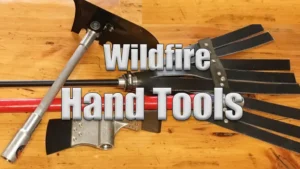




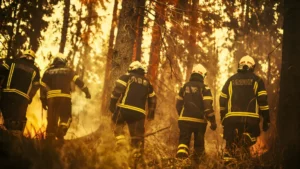





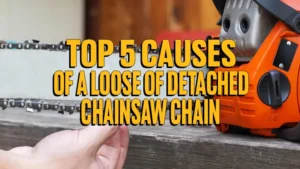
It was my understanding that the Cubic Mini stoves only allow for a vertical vent pipe due to the construction of the stove. This allows them better ventilation and a more efficient burn rate. If I recall, their website states that they do not allow horizontal piping. Your installation, I believe, goes against their warranty. Also, if you are going to install a heat shield, why not install something that will radiate and/or hold heat like soap stone or brick?
Lady_Ianna
October 10, 2023 6:41 pm